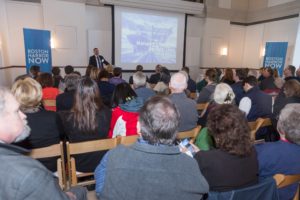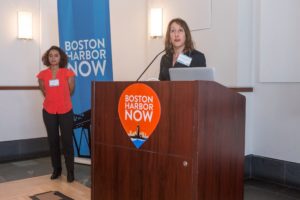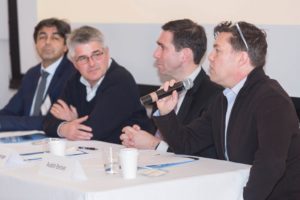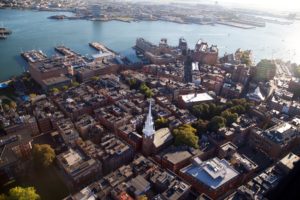5 takeaways from Boston Harbor Now’s two-day Working Port Idea Exchange
Greater Boston’s working ports are at a tipping point. How do we prime our ports for innovation to advance a 21st century Harbor that meets our needs?
This was the key question driving Boston Harbor Now’s two-day Working Port Symposium, which brought together more than 500 stakeholders for a long-overdue discussion about the opportunities and challenges port cities face as they plan the future of their working waterfronts.
The conversation stretched across jurisdictional boundaries to include State and City stakeholders, the public and private sector, and local community groups. The symposium focused on issues of climate resiliency, regional and international competition, diversified funding sources, aging infrastructure, educational opportunities, and community engagement.
Here are some key takeaways from the discussion:
#1: The working port is critical to the economy of the region.

Port activity is an important part of a healthy economy. Despite the persistent myth that ports are a “dying industry”, the maritime economy is growing:
- Boston is one of four major American seafood processing hubs along with Seattle, San Francisco, and Miami
- Flynn Cruiseport Boston is the homeport of 64 ships and saw over 388,000 passengers and 150 cruises in 2017
- Massachusetts is second only to Alaska in spending on oceanographic research and development.
The Seaport Economic Council, appointed by the Governor and charged with promoting the maritime economy, commissioned the University of Massachusetts at Dartmouth’s public policy institute to study the economic impact of the sea. The study found that even through the latest recession, the maritime economy and blue jobs proved to be resilient — supporting $3.4 billion in wages and nearly 90,000 workers,
#2: Working ports can support community access to the waterfront
Dan Adams, founding principal at Landing Studio, questioned the assumption that maritime industry needs are necessarily contradictory to recreational uses. Adams shared an example of the multi-use aspects at the Eastern Salt site along Chelsea’s industrial waterfront, an area mostly used for salt storage that functions as a public basketball court and recreational area during the offseason. This kind of creative thinking can support a vibrant Harbor for all.
#3: The community must be part of conversations about Designated Port Areas (DPAs)

The need for better communication and connections between the working port and abutting communities was clear. Roseann Bongiovanni of Greenroots gave the example of East Boston and Chelsea residents who are engaged and want to be included in all working-port-related decisions affecting their community. Bill Needelman, waterfront coordinator for the City of Portland, offered a cautionary tale from a Portland public process related to a DPA project that stretched over months because the community wasn’t brought in early enough in the process.
Throughout the conference, there was widespread consensus that Boston, with its varied institutes of higher learning, is an ideal place to create opportunities for community educational programs, trade schools, and maritime training courses – but community input is key.
#4: In resiliency planning, ports have unique needs that must be addressed

Port-centric climate change plans focused on band-aid, piecemeal solutions are unlikely to receive federal funds or give Boston the competitive edge it needs to compete with other waterfront cities. Austin Becker, a working port resiliency expert and University of Rhode Island Assistant Professor of Coastal Planning, Policy, and Design reminded the audience that ports rely on roads and utilities, not just waterfront infrastructure, so any resiliency approach needs to be system-wide.
Mia Mansfield, the City of Boston’s Climate Ready Boston project manager, highlighted the comprehensive approach the City is employing for the South Boston waterfront. These solutions will take into account that maritime businesses are by definition water-dependent and cannot be relocated inland.
Threats from sea level rise are especially concerning for working waterfront areas that house chemicals and materials. Tiffany Skogstrom and the team at the State’s Office of Technical Assistance is working to help these businesses identify and prepare for the effects of climate change.
#5: Our waterfronts need broad investment, but the benefits outweigh the costs
Environmental challenges, the emergence of new skilled jobs, the diversification of activities, the boom of mixed-use development, and the rise of the blue economy all demand more of our working waterfront: more flexibility, more innovation, more collaboration, more inclusiveness, more communication – and ultimately, more investment.
Jake Citrin, Principal at Cargo Ventures, and maritime industrial property developer reminded us that building on the waterfront is expensive, and that most maritime industrial businesses operate at a razor-thin two percent profit margin. He challenged the current DPA regulations, which he defined as “thou shall not allow” zones rather than opportunities for growth. According to Citrin, it’s time to accept more direct ways of supporting building and investing in our Designated Port Areas.
What’s next?

Advancing a 21st century Harbor is only possible through careful planning and partnerships. As the civic champion of the working port, Boston Harbor Now is uniquely positioned to guide this conversation. In the coming months we will convene a group of stakeholders that will include state agencies, local maritime businesses, and community advocates to produce recommendations about how to best update port regulations to meet our region’s needs. We will also publish a report with key recommendations and case studies of national and international
What is clear is that tackling the challenges head on and expanding existing opportunities will not only improve the state of our working port but the larger region that benefits from the goods, services, and innovation that come from our unique waterfront.

Comments